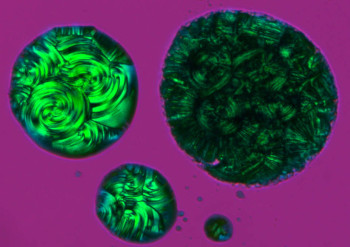Market leaders in temperature controlled microscopy, Linkam Scientific Instruments report on the use of the popular THMS600 heating stage for liquid crystal research at the University of the Free State, Republic of South Africa.
 Phthalocyanine solid and liquid crystal phases imaged using the Linkam THMS600 stage.
Phthalocyanine solid and liquid crystal phases imaged using the Linkam THMS600 stage.
Researchers in the physical chemistry department of the University of the Orange Free State (UFS) have examined the discotic liquid crystal properties of a number of long chain metal free and zinc phthalocyanines using the Linkam THMS600 hot stage. Phthalocyanines are aromatic compounds, with a variable length carbon chain, produced when the phthalocyanine molecule reacts with metals to form brightly colored complexes. These metal and non-metal derivatives are used for many applications, with new uses being continuously developed. They are found in dyes, chemical sensors, catalysts, non-linear optical materials and have been used for photodynamic cancer treatments. Some long chain metal free and zinc phthalocyanines have discotic liquid crystal properties.
Discotic liquid crystals are composed of disk shaped molecules which form parallel layers (nematic phase), or form stacks (columnar phase) within the crystalline structure. The samples were studied using the THMS600 stage in conjunction with an Olympus BH-2 polarising microscope. The scientists were able to determine the existence of the different phases by comparing the observed texture with data from previous X-ray studies. As many as three mesophases were detected within the non-metal and zinc derivative compounds as they were heated. Mesophases are the intermediate phases, between a crystalline solid in an ordered structure and a disordered liquid state. The scientists found changes in observable textures were a function of the heating/cooling rates used; for example when the C15 metal free derivative was cooled at 10°C min-1 the result was a needle like texture while slow cooling at 2°C min-1 resulted in a fan-like texture.
Dr. Eleanor Fourie, a lecturer in the department, commented that they had been using the system for over seven years for "a variety of applications including organometallic synthesis and associated studies. The microscope and Linkam hot stage are used to test the liquid crystal properties of some phthalocyanines. It is also used for basic melting point determinations." These compounds were of specific interest as some phthalocyanines within their mesophase have shown rapid response and recovery time to gas exposure and the zinc phthalocyanines in particular have demonstrated beneficial properties for cancer photodynamic therapy.
The properties of each compound are dependent on chain-length and metal constituent, and with the large number of variants to study, the research on synthesis, properties and industrial applications is an ongoing project. As they are understood better, these highly useful chemicals become relevant to old, new and cutting edge scientific applications.
The Linkam THMS600 stage is one of the most widely used microscope stages on the market with over 4000 having been sold to date. The THMS600 can be used in many applications where high heating/freezing rates and 0.1°C accuracy are needed. With a wide temperature range of -196°C to 600°C, samples can be quickly characterized by heating to within a few degrees of the required temperature at a rate of up to 150°C min-1 with no overshoot, then slowed down to a few tenths of a degree per minute to examine sample changes closely. The entire experiment can be saved as an online plot or exported to a spreadsheet application. There are various options for this stage, including pressure, vacuum, electrical sample measurement and sample holders to mount the stage vertically in IR or x-ray spectrometers.
Visit Linkam and learn about the broad range of applications in the field of temperature-controlled microscopy.